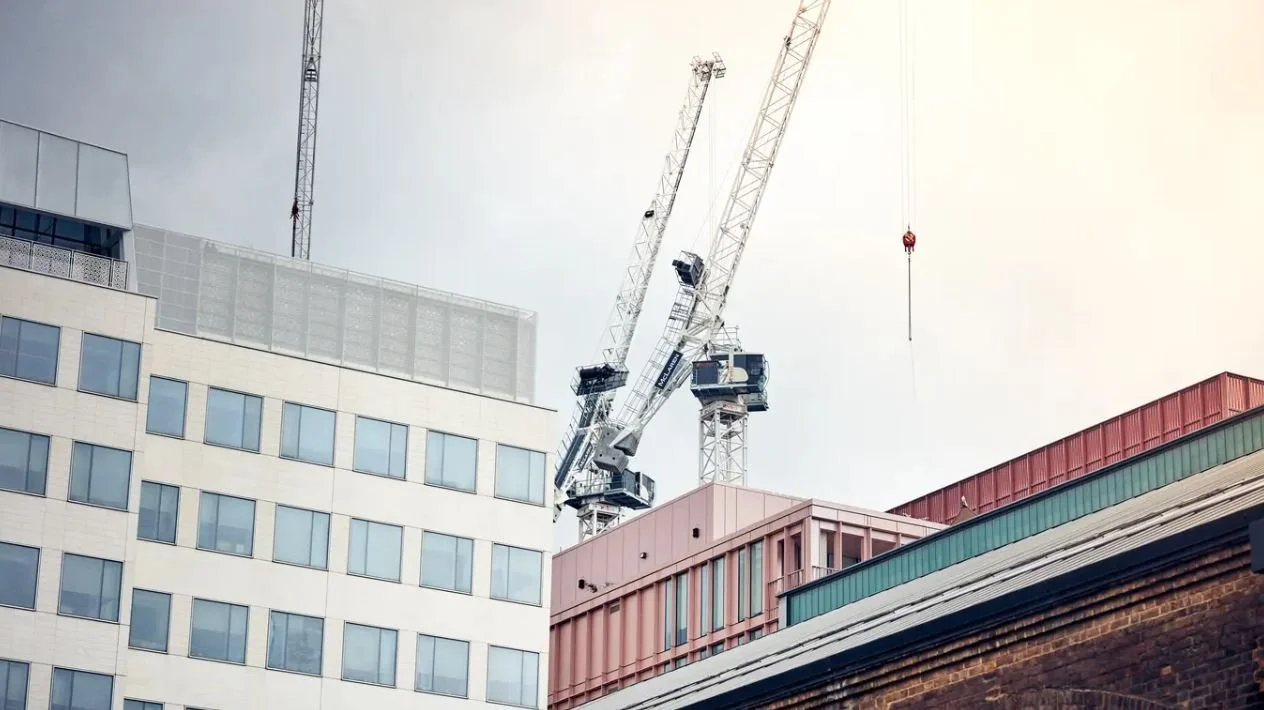
ARTICLES

Risk and Resilience of a Circular Economy in the Construction Industry Amid Political and Trade Uncertainty
Carbon capture and storage (CCS) is emerging as a powerful tool in sustainable construction. By capturing CO₂ emissions and storing them safely, CCS helps reduce the industry’s carbon footprint—especially in high-emission materials like concrete and steel. Innovations like carbon-absorbing concrete and bio-based materials are already in use, with projects such as CarbonCure and The EDGE in Amsterdam leading the way. While costs and infrastructure remain challenges, ongoing innovation and policy support are accelerating adoption, positioning CCS as a key solution for a low-carbon built environment.

The Role of Carbon Capture and Storage (CCS) in Sustainable Construction
Carbon capture and storage (CCS) is emerging as a powerful tool in sustainable construction. By capturing CO₂ emissions and storing them safely, CCS helps reduce the industry’s carbon footprint—especially in high-emission materials like concrete and steel. Innovations like carbon-absorbing concrete and bio-based materials are already in use, with projects such as CarbonCure and The EDGE in Amsterdam leading the way. While costs and infrastructure remain challenges, ongoing innovation and policy support are accelerating adoption, positioning CCS as a key solution for a low-carbon built environment.

Adaptive Reuse: Breathing New Life into Old Buildings
Adaptive reuse isn’t just about repurposing buildings—it’s a transformative approach to sustainable development. By retaining existing structures and adapting them for new uses, it drastically reduces material waste, preserves cultural heritage, and minimizes the carbon footprint of construction. This strategy bridges the past and present, ensuring that historical architecture remains functional in a modern landscape. While challenges such as regulatory hurdles and renovation costs exist, the long-term benefits—resource conservation, urban revitalization, and reduced environmental impact—position adaptive reuse as a key solution for sustainable growth in the UK’s built environment.

Understanding the Proposed Part Z Building Regulations: A Step Towards Sustainable Construction
Part Z isn’t just another regulation—it’s a paradigm shift in how we approach building sustainability. By mandating Whole Life Carbon Assessments and setting strict emission limits, it moves beyond operational energy efficiency to tackle the full carbon footprint of construction. This holistic approach ensures that materials, processes, and long-term impacts are all factored into design decisions. While challenges like higher upfront costs and industry adaptation exist, the long-term benefits—lower emissions, innovation in sustainable materials, and alignment with net-zero goals—position Part Z as a crucial step toward a greener, more responsible construction industry.

Systems Thinking in Construction: A Holistic Approach to Sustainable Building
Sustainable construction isn’t just about materials or energy efficiency—it’s about the entire system. Traditional methods optimize components in isolation, missing how materials, energy, water, and waste interact. Systems thinking takes a holistic approach, aligning circular economy principles, lifecycle analysis, and green infrastructure to create buildings that are resource-efficient, resilient, and regenerative. While it requires collaboration and new skills, the long-term benefits—lower emissions, reduced costs, and greater environmental impact—make it essential for the future of sustainable building.

Energy Management and Operational Efficiency
Inefficient energy use on construction sites is a major but often overlooked contributor to emissions. While Scope 3 dominates sustainability discussions, the real issue starts with poorly managed on-site power—oversized diesel generators, inefficient load distribution, and a lack of strategic energy planning. Solutions like high-output battery storage, load-on-demand systems, and hybrid power arrangements can significantly cut waste, but the most impactful shift is transitioning to mains power. Though complex, early coordination with network operators and suppliers can eliminate on-site emissions and reduce long-term costs, making energy efficiency a key driver in the industry's net-zero transition.

Pre-Demolition Audits: A Practical Step Towards Sustainable Construction in London
As London accelerates its commitment to sustainable construction, pre-demolition audits have emerged as a vital tool in embedding Circular Economy principles into redevelopment projects. These audits go beyond compliance, focusing on material recovery, waste reduction, and resource efficiency. By systematically assessing buildings before demolition, developers can identify reusable and recyclable materials, minimising landfill contributions while optimising sustainability outcomes. From structural components to non-structural elements, the pre-demolition audit provides a clear roadmap for integrating salvaged materials into new projects, aligning with the Greater London Authority’s Circular Economy Statement and shaping a more responsible built environment.

Before You Build: How Pre-Redevelopment Audits Set the Stage for a Greener Future
As London advances its sustainable urban development agenda, pre-redevelopment audits have become essential for aligning construction projects with the city’s Circular Economy goals. These audits go beyond material assessments, focusing on vertical and horizontal extensions, light and deep retrofits, and partial building retention. By conducting a thorough feasibility analysis, developers can optimise sustainability, functionality, and compliance with Greater London Authority regulations. From structural evaluations to MEP system upgrades, pre-redevelopment audits provide a comprehensive roadmap for transforming existing buildings into modern, eco-friendly spaces that meet the city’s evolving needs.

Modern Methods of Construction (MMC) and Upfront Embodied Carbon
Modern Methods of Construction (MMC) are gaining traction as a sustainable alternative to traditional building methods, heavily emphasised in the UK Government’s ‘Construction Playbook’. This article examines the impact of MMC on upfront embodied carbon in construction, comparing steel modular, precast concrete, and engineered timber systems with conventional reinforced concrete practices. Through case studies and surveys involving 40 construction professionals, the study reveals insights into MMC’s carbon efficiency, limitations, and practical applications, advocating for project-specific evaluations to enhance sustainability.

Extended Producer Responsibility: A Game-Changer for the UK Construction Industry
Extended Producer Responsibility (EPR) is transforming the UK construction industry by shifting the responsibility for managing product end-of-life onto producers. This policy encourages sustainable design, recycling, and innovative packaging while reducing environmental impact. For the construction sector, EPR affects everything from cement bags to protective wrapping. It introduces obligations like reporting packaging data, paying fees, and incentivizing sustainable material use. Though it may seem like a challenge, EPR is a chance for the industry to lead in sustainability, fostering collaboration, innovation, and long-term financial benefits.

Embodied Ecological Impacts: The Hidden Environmental Cost of Infrastructure
When we think of sustainability, we often focus on visible elements like emissions or waste. But what about the hidden environmental costs embedded in a product's lifecycle? This thought-provoking article dives into embodied ecological impacts, shedding light on how materials, energy, and resources used in production contribute to environmental challenges. Learn how to identify, measure, and mitigate these impacts to foster truly sustainable solutions.

The Sustainable Structures Trilemma
In "The Sustainable Structures Trilemma," Richard O’Hegarty explores the complex balance between efficiency, longevity, and flexibility in sustainable building design. He argues that while embodied carbon calculations are essential, they are just one tool among many. O’Hegarty delves into the challenges of creating structures that not only minimise material use but also stand the test of time and adapt to future needs. He emphasises that achieving true sustainability requires a holistic approach, considering immediate carbon reductions alongside long-term durability and adaptability.
This article is a must-read for professionals and enthusiasts in sustainable architecture and engineering, offering valuable insights into the multifaceted nature of building sustainability.

Wood as a Carbon Sink: The Environmental Promise of Timber Construction
In the shift toward a sustainable future, timber construction offers a promising solution to climate change by acting as a carbon sink, or a store of carbon dioxide absorbed by trees over their lifetimes. Unlike traditional building materials, timber can “lock in” carbon, keeping it out of the atmosphere as long as the structure stands. This unique ability to sequester carbon makes timber a compelling choice in the construction industry, but it also raises important considerations. Factors such as timber's lifespan, decomposition, and the re-release of carbon upon decay or combustion all influence its effectiveness as a sustainable material. This article explores the complexities of carbon sequestration in timber, the calculations involved, and the challenges of including timber’s stored carbon in climate targets, shedding light on both the potential and the limitations of using wood to support global climate goals.

Urban Mining: Uncovering the Treasure in Our Cities
Urban mining redefines our approach to resources by transforming cities, buildings, and infrastructure into valuable reserves of reusable materials. Unlike traditional mining, which extracts resources from natural ecosystems, urban mining reclaims materials from the built environment—offering an eco-friendly, efficient way to reduce waste, lower carbon emissions, and conserve raw resources. As urban mining gains momentum, it aligns with the circular economy’s goals, reducing landfill use, boosting sustainable construction, and fostering green job creation. This innovative approach promises a regenerative future, where cities evolve as resource-rich hubs, supporting sustainable development and economic resilience.

Unveiling the SCI P440: A Supplementary Guide to Reusing Pre-1970 Steelwork
The SCI P440 is a pivotal guide for the sustainable reuse of pre-1970 steelwork in construction. Building on the SCI P427, this document addresses the unique challenges of reusing older steel, which differs from modern steel in composition and structural characteristics. With specific guidelines for material testing, design considerations, and safety compliance, SCI P440 enables construction professionals to safely integrate reclaimed steel from the pre-1970 era into new projects. This approach not only supports sustainable building practices but also aligns with the circular economy by conserving resources and reducing environmental impact.

Clearing the Air on A4 Emissions: A Guide for Timber Construction
In this guide, we delve into the importance of understanding A4 emissions in timber construction and how these emissions impact sustainability efforts. By examining practical solutions and innovative approaches, we aim to provide construction professionals with the knowledge needed to reduce their environmental impact while promoting eco-friendly practices in building projects.

The Role of AI in Sustainable Construction: Smart Designs for a Greener Future
Artificial Intelligence (AI) is transforming sustainable construction by enhancing energy efficiency, reducing waste, and enabling smarter building designs. In the UK, AI-driven tools are helping architects and engineers optimise resources and minimise environmental impact, moving the industry closer to a greener future. From predictive maintenance to energy management, this article explores the key ways AI is advancing sustainable construction and its potential for future innovations.

Decoding the UK Net Zero Carbon Buildings Standard: A Blueprint for Sustainable Construction
The UK Net Zero Carbon Buildings Standard (NZCBS) is setting a new standard for sustainable construction, providing a comprehensive framework to guide buildings toward achieving net-zero carbon emissions. This article breaks down the NZCBS's core components, from operational carbon reduction to embodied carbon assessment, highlighting the opportunities and challenges for the construction industry as it strives to align with the UK’s 2050 climate goals.

Design for disassembly: future proofing our building stock
“Design for Disassembly" (DfD) promotes adaptable, eco-friendly buildings by allowing construction materials to be easily disassembled, reused, or recycled. This method significantly cuts down waste and environmental impact, aligning with the UK's sustainability targets. Jame’s insights illustrate how DfD can bolster the resilience of the construction sector by supporting resource-efficient practices and creating structures that can evolve with future needs.

Implementing a Circular Economy - Understanding ISO 59004:2024
The transition to a circular economy is essential for sustainable growth and environmental resilience. ISO 59004:2024 offers a comprehensive framework for organisations to embrace circular economy principles, focusing on resource efficiency, value creation, and ecosystem stewardship. This article explores the key concepts, actions, and strategies outlined in ISO 59004:2024, guiding organisations on the path to sustainability and long-term success.